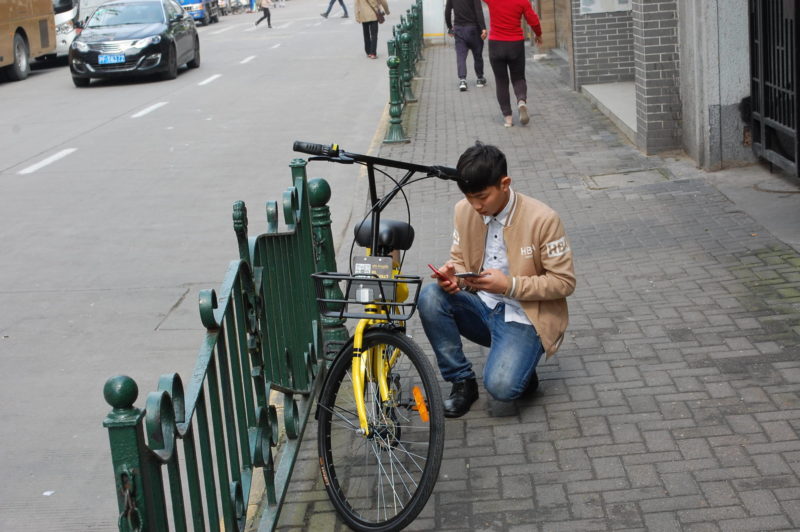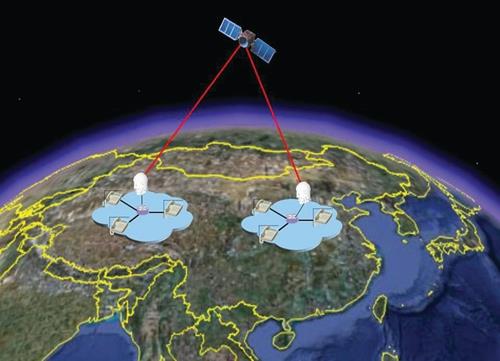What innovations in China will change the world’s game and how?
Mobile payment and the online to offline (O2O) model, as well as the introduction of several sharing apps like Mobike (摩拜单车), can be world game changers. But also innovations in China in quantum physics, supercomputing and Artificial Intelligence (AI) are affecting the world.
The question if these are true innovations of China might arise. Indeed, in the modern age, China is not really known for world game changing inventions like in the past with inventions such as the paper or gunpowder. However, innovation doesn’t equal invention, which is the creation of a whole new product or process (like the introduction of paper in ancient China, for instance). An innovation, on the other hand, can also be viewed as the application of a better solution, e.g. to meet unmet market needs or new requirements. And China is a champion at this.
Anyone from the West will know the struggle when paying in cash in a supermarket. The pressure one is feeling collecting the change while there is a large queue waiting behind one. Even when paying with debit- or credit card, it takes a while to pay because one has to show an ID or sign. In China, especially in the Tier-1 and -2 cities, one can barely see this. Mobile payment in China became the norm and it can be a real world game changer. Not only that it can save consumers from stress while paying in a supermarket, whole new business models are developed on the basis of it which is the real world game changer. Models like O2O or sharing apps are only thriving because of the rise of the mobile payment in China and the use of mobile payment services such as Alipay (支付宝) and Tenpay (财付通), the WeChat Wallet. Compared to the US, China shows a far higher affinity to mobile payment with a transaction volume of US$ 5.5 trillion (US: US$ 112 billion).
The example of bike sharing apps such as Mobike or Ofo (共享单车) show how China didn’t invent one but innovatively applies a service. Sure, there are also bike sharing apps in other countries – however, the way it is used in China is different. Consumers in China connect their phones via the above-mentioned services with their bank account and simultaneously, it can be connected with the apps. Therefore, the setup of the app is a lot easier than in other countries, where, e.g. a credit card needs to be connected (which involves a lot of security checks). This increases the number of users a lot.
Foolow us to learn more about China’s collaborative economy:
The #collaborativeeconomy in #China will account for 10% of China’s GDP in 2020 https://t.co/Ach4pdtyWB @sharingcity @CoopsEurope pic.twitter.com/Dk3mTiODR9
— Daxue Consulting (@DaxueConsulting) June 22, 2017
The latest figure by Daxue Consulting showed that since the introduction of the bike-sharing models last year, the number of users is constantly increasing – with a month-over-month growth of more than 100% in March this year. Because of this ease in terms of accessibility, China became global leader in the whole on-demand transportation market (bike- as well as car ride-sharing), accounting a share of incredible 67%. This success shows how the Chinese model can change the way people use transportation systems globally.

An ‘Ofo’ bike easily unlocked on the streets in Shanghai; photo credit: Daxue Consulting
The O2O model is another example of how the innovative use of mobile payment in China can change the world’s game. In a world where it was commonly believed that offline brick-and-mortar shops will be absorbed by e-retailing, China shows how one can merge these two. Again, let’s have a look at a common problem in the West. For instance, the e-retailer Zalando, which is very popular in Europe for selling every kind of shoes, clothes, and accessory, advertises with the convenience of being able to send back everything for free. However, the consumer still has to go to the post office and wait for the next delivery. In fact, a model where the consumer could return, for instance, the shirt he or she just bought in-store of the particular brand and try on and purchase another one, would be more convenient. China picks up on that.
In general, O2O can mean several things in China as the consumer expects a holistic service. First of all, O2O describes ‘click and collect’ services where physical goods are purchased online and collected in-store. As of 2016, according to a research of Daxue Consulting on O2O in China, 72% of the Chinese consumers expect the opportunity to buy online and return or exchange offline. Also, the majority of the Chinese consumers want to buy coupons online and redeem them in-store. Further O2O services involve offering product customization online before the purchase, checking the physical store stock status online as well as the possibility to purchase a good in-store and have it automatically delivered to the consumer’s home.
The latter shows again how the combination of mobile payment and the QR code technology in China is changing the game. While brick-and-mortar shops were assumed to vanish because consumers either buy the good online immediately or only go to the offline shop to evaluate and then find the best offer online, this innovation gives those shops an economic sense again. Implementing QR codes next to a product in the particular shop enables the consumer to see detailed info about it. For instance, the consumer can see the traceability of a certain product to buy with more confidence. An example is Leyou (乐友), China’s largest retailer of baby products, who implemented QR codes so parents can track the product and get additional information to be sure it’s the best for their baby. With mobile payment such as Alipay being standard, not only this information can be seen but the products can be easily purchased and delivered home.
Another innovative way of how mobile payment in China connects the offline stores to the online world would be Dmall (多点), an application that turns nearby supermarkets into virtual ones. The app shows the stocks of the supermarkets and the consumer selects the desired goods. Consumers pay via Alipay or WeChat and the goods will be delivered within one hour. In doing so, it can change the way consumers worldwide purchase their food and household items. Especially, if one recalls the comparison from the beginning with the supermarkets and their large queues, this can be an extremely effective innovation. Firstly, for customers saving the effort of shopping themselves, secondly, for supermarkets to not potentially loose customers to others because the offline store might be too crowded in that moment and thirdly, it creates further jobs.
If the rest of the world is able to adapt this innovative use of mobile payment in combination with the QR code technology, it can change the way people purchase, consume and share things globally. Hence, it affects the whole world’s economy as companies need to overthink their business models (e.g. effectively connecting online and offline operations) and startups with completely new business ideas based on mobile payment will arise all over the world.
Reasons for China’s thrive and the West’s lack at the same time
However, it is about the question if the rest of the world is able to adapt to the Chinese standards of today. So what are the drivers for this thrive of mobile payment and O2O in China? And does it explain at the same time why the West is behind?
One key reason for the facilitation of mobile payment in China is the low credit card penetration in China. For example, the overall credit card penetration in China was only at 16% in 2014, according to the latest report from the Demand Institute on financial services in China. Even if one looks on the penetration rate among urban consumers with financial accounts, it is only at 41% for the 1990s cohort, compared to 77% in the US in the same cohort, for instance. The main reason for this low credit card penetration in China is the fact that the Chinese prefer mortgages for loans, making up around 75% of the whole Chinese credit market. This catalyzes the mobile payment business which increased to 25.71 billion transactions made (with a volume of RMB 157.55 trillion) in 2016, an 86% increase Year-on-Year (YoY).
The basis of the mobile payment systems in China is the ubiquity of the so-called “quick response” (QR) codes. The ease of just scanning a code to transfer the money to the particular supermarket, restaurant or even the littlest street food stand further propels the usage of the mobile payment systems. In combination with the fact that consumers, no matter where from, don’t easily switch among different payment methods unless there are clear benefits, it explains why mobile payments are thriving in China but not in the West.

The ubiquity of mobile payment systems proven by a little Chinese coffee shop in Shanghai that only accepts scan codes; photo credit: Daxue Consulting.
In terms of the O2O model, China again shows unique characteristics which cannot be observed in the West. The main driver for innovatively and effectively implementing new O2O services are clearly the cheap labor costs. This enables inexpensive delivery which is the basis of most O2O models in China. From ordering something offline in a shop via QR code and mobile payment and getting it delivered to ordering food online and getting it delivered home, nowadays it is inevitable to see a delivery guy once one goes on the street.
The food delivery, such as market leader Ele.me (饿了么), is a good example how psychological factors in the Chinese culture also play an important role for the thrive of O2O in China. Everything unclear is suspicious at first. The Chinese always want to be in control, that’s why, for instance, online food delivery services continuously need to improve their tracking capabilities. This makes those service a lot more enhanced than its Western counterparts.
[ctt template=”2″ link=”776_d” via=”yes” ]Online food delivery services in China continuously improve their tracking capabilities.[/ctt]
All in all, one can say that China embraces mobile payment and O2O with a unique commercial landscape. Especially due to a low credit card penetration and cheap labor costs, the innovative application of mobile payment and development of several O2O models is made possible and successful in China. On the other hand, as it is the exact opposite in the West, it still lacks to adapt to the possibilities available through those innovative business models.
Other technological innovations in China that could be world game changers
But not only mobile payment and its facilitation of sharing platforms and O2O is changing the world’s game. Chinese supercomputers are by far the fastest and hence, influence the way scientists and engineers can use supercomputers all over the world. Supercomputers are high-level performance computers measured by how many calculations they can do in a second (FLOPS, floating-point operations per second). Nowadays, supercomputers can do quadrillion calculations per second (PFLOPS), with two Chinese supercomputers leading the ranking of the fastest computers worldwide. The fastest supercomputer, Sunway TaihuLight (神威·太湖之光), located in the city Wuxi (runs at a speed of 93 PFLOPS, which is almost more than 5 times faster than the first non-Chinese supercomputer from Switzerland with 19,5 PFLOPS, according to the latest Top 500 list released in June this year.
While supercomputing itself is not a sole innovation by the Chinese, it is, again, about how the Chinese apply it. Was the fastest Chinese supercomputer in 2002 only ranked 43rd in the world, China is now reining the field. In doing so, Chinese supercomputers can simulate the reality not only faster but also more accurate. For instance, supercomputing is used for weather forecasting and climate change research where meteorologists need to analyze constantly changing data as accurate as possible. However, game-changing could be the simulation of how new medications and drugs react to the human body and physical simulations such as calculating the early moments of the universe or airplane and spacecraft aerodynamics. The ultimate goal of supercomputers is to simulate human brain activity. As a matter of fact, China is already developing a new supercomputer in Jinan (which is supposed to be able to do quintillion calculations per second, thus being height times faster than the current leading supercomputer. By constantly keeping up the pace of building faster supercomputers, China forces the rest of the world to do so, too. In doing so, with developing better supercomputers, calculations and simulations get more accurate and impactful in several industries all over the world.
Related to supercomputers is Artificial Intelligence (AI), the exhibition of intelligence by machines. As far as AI has come, it will probably keep growing in China. In fact, the next big step in AI evolution may come from BAT (Baidu-Alibaba-Tencent, the three major technological companies). Indeed, China is heavily invested in the success of AI, with billions of dollars poured in, between major companies, start-ups and universities. For instance, Liu Lihua (刘利华), Vice Minister of Industry and Information Technology, assured that China had applied for 15.745 patents related to AI, according to China Daily. Furthermore, China’s AI industry increased by 43.3 percent YoY in 2016, surpassing RMB 10 billion (US$1.47 billion), and is expected to reach RMB 15.21 billion and RMB 34.43 billion in 2017 and 2019 respectively, according to the Chinese Academy of Sciences (CAS, 中国科学院). Also, just last month on July 20th, China’s State Council issued the “Next Generation Artificial Intelligence Development Plan” (新一代人工智能发展规划), which foresees an ambitious agenda to become world-leading in AI. The plan will give funds to AI-related projects, such as the CAS Institute of Automation, a Beijing consortium of companies and universities.

Reproduced by Daxue Consulting with data from: CAS, China State Council
Moreover, the goal is to turn China into the global power of AI by 2030. According to the State Council’s report, China’s target is to exceed a value RMB 150 billion in 2020, RMB 400 billion in 2025 and RMB 1 trillion on 2030 to become world leader and surpass the US. Indeed, Chinese tech giants Baidu and Tencent have established AI research centers in the United States. Baidu, in particular, has been extremely bullish on the industry, at one point hiring Andrew Ng – a leading AI expert – as its chief scientist.
AI could play a big role in China’s development, from driverless cars to automated decisions and inventory decisions. Jack Ma, China’s richest man and CEO of Alibaba, claimed that in 30 years, CEOs could be replaced by robots.
[ctt template=”2″ link=”ftncl” via=”yes” ]AI in China keeps growing: in 30 years, CEOs could replaced by robots according to Jack Ma.[/ctt]
AI has become such an important investment for several reasons: first of all, AI is able to predict the needs and behavior of humans or of a company faster than a human, potentially saving millions of dollars for a company, or helping us gain more time (predicting we are running out of milk and buying it online for example). Furthermore, as predicting the near future becomes strategically important, marketing and other departments all over the world would crave such a tool to use it to estimate whether their product will be successful without investing tens of millions of dollars in market studies.
Secondly, with the rise of robotics, AI could become an accessory to do what we can’t or won’t do. One good example is a robot going into a forest fire.But AI can also save costs for the logistics all over the world through autonomously driving trucks that ensure with intelligent routing the best delivery networks. Lastly, China also found another way to use AI: for predicting crimes. According to Li Meng (李萌), China’s Vice Minister of Science and Technology, crime prediction is one of the most important uses of AI for the Chinese government. With AI, personal data of potential suspects can be gathered and surveillance footage can be analyzed, including “crowd analyzes” to detect suspicious behavior. While this idea is very noble and indeed could change the world in terms of lowering crimes, it is highly doubted the rest of the world will adapt to it due to privacy regulations.
Finally, Chinese quantum scientists have gone a long way to prove themselves better than their international counterparts in quantum physics. Thanks to the outstanding universities that have popped up across the country, Chinese scientists have achieved a great deal in quantum physics over the past few years.
The latest achievement that proved invaluable to the global scientific community was beaming entangled photons from space to Earth, using a satellite. Basically, the experience was to break the sunlight to its smaller element, the photon. These photons were then sent over two observing stations, which were 1500 miles apart.

An illustration of the experiment of beaming photons from space to earth; photo credit: CAS
Although this seems hard to comprehend, the final idea is that in the future, using photons (i.e light) to transport data around the world. Although so far only military communications are seeing the potential of the technology, public companies could develop their own network of satellites to use the technology and bring faster information to their customers.
Furthermore, Chinese scientists achieved to create a quantum computer. The scientists announced it at Shanghai Institute for Advanced Studies of University of Science and Technology of China (上海理工大学高级研究所). The computer they have created could be 24.000 times faster than other supercomputers. However, this doesn’t question the capabilities and plans with the above-mentioned supercomputers as such quantum computers can only solve certain problems. Still, Chinese Quantum Physics are now toe to toe with the USA, and may even be in the lead for the next giant leap in quantum technology and thus, yet again, China can influence the world’s game in another industry.
Concluding, one can say that those innovations in China are potential world game changers especially in two ways: first, the innovative use of mobile payment influences the way consumers buy and share goods. Moreover, innovations in computing lead to great improvements of how scientists can calculate and simulate things. In doing so, it can change the way we can simulate reality and hence is affecting many industries like medical/pharmaceutical industry or the logistics.
Some tangible “real” recent inventions from China
Nonetheless, China also invented other physical products from scratch in the recent past that changed the world. Most of all the e-cigarette. Hon Lik (韩力), a Chinese pharmacist, invented the modern e-cigarette in 2003. Driven by the will to quit smoking himself after his father’s death (which was caused by his smoking habits), he found that he can only stop smoking without suffering through another form of smoking. His breakthrough idea was to use a piezoelectric ultrasound element to vaporize a nicotine solution in a cigarette-resembling device, on which he registered a patent in the US. After the patent was bought by the giant tobacco firm Fontem Ventures, more and more versions of e-cigarettes came up. Nowadays, various flavors, with or without nicotine, can be purchased, helping consumers all over the world to quit or reduce smoking normal cigarettes.
Another recent invention by Chinese entrepreneurs of the company Ehang (in China known as Beijing Yi-Hang Creation Science & Technology Co., Ltd. (北京亿航创世科技有限公司)) is the world’s first passenger drone called Ehang 184 (亿航184). It got revealed at the CES in Las Vegas last year and could be a real world game changer. The single passenger drone shall work as an autonomously flying taxi-service. This electric-powered drone is designed to fly up to 23 minutes at a maximum altitude of 3.5km and able to carry a passenger up to 100kg. The passenger creates a route via a tablet inside the drone before the flight and then commands the drone just in two ways: “Take off” and “land”. While this invention is not yet as much implemented in real life as the e-cigarette, it shows a lot of potential for solving transportation issues in metropoles with many traffic jams when more sophisticated.
The case of the passenger drone is a good keyword for how Daxue Consulting can help with innovative projects. With our innovation practice, Daxuenova, we already worked on innovation in aeronautics and transportation, for instance. Clément Mougenot, Research Director at Daxue, explains how the services of Daxuenova are provided: “At Daxuenova, we use two main methodologies: first, in-depth interviews with market insiders and second, deep desk research and existing resources such as reports, thesis and other existing sources.” Leveraging these methodologies, for instance, “helps us to identify and understand relevant technologies for the client. Also, we can understand the use of new technologies and new products by consumers”, continues Mougenot. In terms of a previous assignment in aeronautics, we could successfully design a go-to-market roadmap for a new type of product as well as design a pricing strategy for this new product.

Clément Mougenot, Research Director of Daxue Consulting
Contact us here to get further information about the particular industries or visit Daxuenova right away to get information about how we can help with innovation-related topics.

The Research Team of Daxue Consulting in Shanghai





